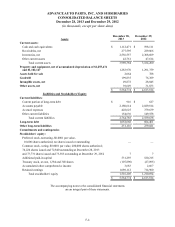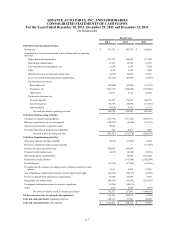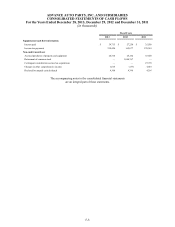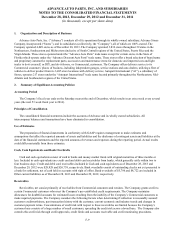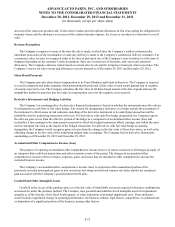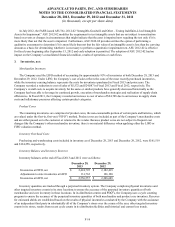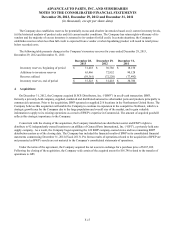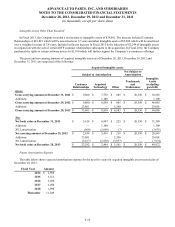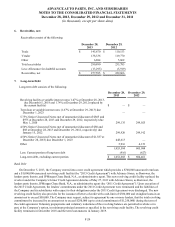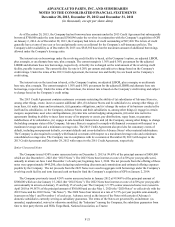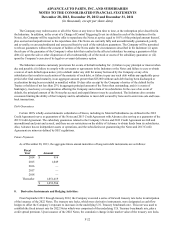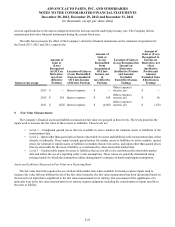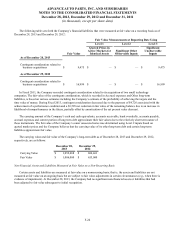Advance Auto Parts 2013 Annual Report Download - page 66
Download and view the complete annual report
Please find page 66 of the 2013 Advance Auto Parts annual report below. You can navigate through the pages in the report by either clicking on the pages listed below, or by using the keyword search tool below to find specific information within the annual report.ADVANCE AUTO PARTS, INC. AND SUBSIDIARIES
NOTES TO THE CONSOLIDATED FINANCIAL STATEMENTS
December 28, 2013, December 29, 2012 and December 31, 2011
(in thousands, except per share data)
F-14
include the renewal period in its amortization period. In those instances, the renewal period would be included in the lease term
for purposes of establishing an amortization period and determining if such lease qualified as a capital or operating lease. In
addition to minimum fixed rental payments, some leases provide for contingent facility rentals. Differences between the
calculated rent expense and cash payments are recorded as a liability within the Accrued expenses and Other long-term
liabilities captions in the accompanying consolidated balance sheets, based on the terms of the lease. Deferred rent was $50,638
and $45,791 as of December 28, 2013 and December 29, 2012, respectively. Contingent facility rentals are determined on the
basis of a percentage of sales in excess of stipulated minimums for certain store facilities as defined in the individual lease
agreements. Most of the leases provide that the Company pay taxes, maintenance, insurance and certain other expenses
applicable to the leased premises. Management expects that in the normal course of business leases that expire will be renewed
or replaced by other leases.
Property and Equipment
Property and equipment are stated at cost, less accumulated depreciation, or at fair value if acquired through a business
combination. Expenditures for maintenance and repairs are charged directly to expense when incurred; major improvements are
capitalized. When items are sold or retired, the related cost and accumulated depreciation are removed from the account
balances, with any gain or loss reflected in the consolidated statements of operations.
Depreciation of land improvements, buildings, furniture, fixtures and equipment, and vehicles is provided over the
estimated useful lives, which range from 2 to 40 years, of the respective assets using the straight-line method. Depreciation of
building and leasehold improvements is provided over the shorter of the original useful lives of the respective assets or the term
of the lease using the straight-line method.
Closed Store Liabilities
The Company continually reviews the operating performance of its existing store locations and closes or relocates certain
stores identified as underperforming or delivering strategically or financially unacceptable results. Expenses pertaining to
closed store exit activities are included in the Company’s closed store liabilities. Closed store liabilities include the present
value of the remaining lease obligations and management’s estimate of future costs of insurance, property tax and common area
maintenance expenses (reduced by the present value of estimated revenues from subleases and lease buyouts) and new
provisions are established by a charge to SG&A in the accompanying consolidated statements of operations at the time the
facilities actually close.
From time to time closed store liability estimates require revisions, primarily due to changes in assumptions associated
with revenue from subleases. The effect of changes in estimates for our closed store liabilities impact both our income
statement and balance sheet: (i) they are included in SG&A in the accompanying consolidated statements of operations, and (ii)
they are recorded in Accrued expenses (current portion) and Other long-term liabilities (long-term portion) in the
accompanying consolidated balance sheets.
The Company also evaluates and determines if the results from the closure of store locations should be reported as
discontinued operations based on the elimination of the operations and associated cash flows from the Company’s ongoing
operations. The Company does not include in its evaluation of discontinued operations those operations and associated cash
flows transferred to another store in the local market.


